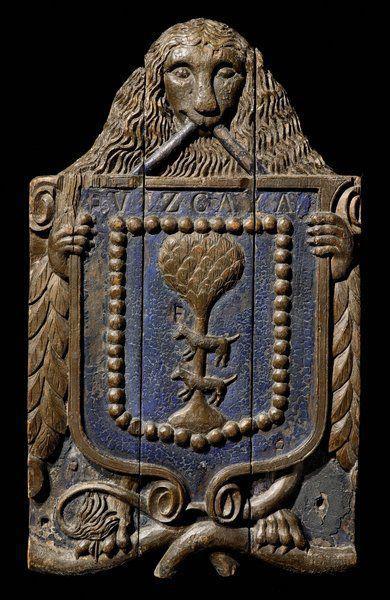A magnificent, late-16th century, Spanish, carved & painted armorial
10240
The head of the shield has the name 'VIZCAYA' incised across the panels. The shield itself shows the coat of arms arms of the Spanish Province of Vizcaya or Biscaya within a gilded, shield-shaped ribbon of pearls. The coat of arms of Vizcaya contains the Tree of Gernika and two wolves, each carrying a lamb in its mouth. The wolves are eloquent images since Otso (wolf) was the name of the Lord of Vizcaya. The shield is supported by a magnificent, primitive lion within a foliate border. Carved from three solid, thick planks. Retaining original gilding and blue pigments. Fourth quarter of the 16th century.
11051518
Vizcaya
The Basque homeland is a compact area straddling the western Pyrenees, including four provinces of Spain (Navarra, Guipuzcoa, Vizcaya, and Alava) and three of southwest France (Labourd, Basse Navarre, and Zuberoa). The Basque Country as we know it today, that is, the seven Basque provinces, was never a state. Aside from the thirty years of the Kingdom of Navarra under Sancho the Great (1004-1034), the Basques never had political unity. Even so, there was never a political unity of the seven provinces since Navarra was a kingdom, while Vizcaya was once a seigniory and Guipúzcoa was an old "País de Comunas" or Country of Communes. Each of the seven provinces has been independent of foreign nations and its sister provinces. But even while preserving this individuality, there has existed a common tie among them, that of the oath sworn beneath the tree of Gernika to unite against foreign invasion in order to defend the Basque race, culture, language, customs, and fueros. The fueros were multi-secular liberties created by and for the Basque people and demonstrated by means of ancient customs transmitted orally. These old laws were not privileges granted by the Spanish kings, but rather rights born among the people. These fueros or Basque institutions dating from ancient times survived in the north until the French revolution in 1789 and in the south until the end of the second Carlist War in 1876 when they were abolished. Thus in the Middle Ages, when feudalism was rampant in Europe, there were neither feudal lords nor serfs in the Basque Country. Another difference worthy of mention is that women held the same rights of inheritance as men. The Basque fueros were impregnated with the spirit of liberty even where kings were concerned. As a result, the commands of the kings of Castilla were not binding for the Basques. It was necessary for those kings to swear an oath to respect the Basque fueros before commanding the Basque people. Obedience to the kings, based on their previous respect for ancient Basque traditions, was the norm for Basques in the north as well as the south. For example, the Kingdom of Navarra was a federation of small nations united under one king who freely swore to respect the fueros. The Juntas Generales, or General Assemblies, of Vizcaya met beneath the Tree of Gernika.
16th Century
1575
Spanish
Commemorative













